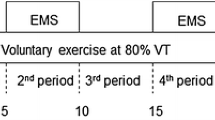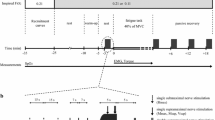Abstract
Adult domestic pigeons, with thermodes chronically implanted in the vertebral canal, were trained to walk on a treadmill. In the first series of experiments, EMG activity in a pectoral (M. pectoralis) and a femoral muscle (M. biceps femoris) was measured to determine if shivering could occur during exercise. When the spinal cord was cooled (36.2±0.5°C) during exercise (0.6 km/h), pectoral muscle EMG activity increased by 80%, while femoral muscle EMG activity did not change significantly. EMG activity remained unchanged during exercise in control experiments where the spinal cord was not cooled.
In the second series of experiments, the spinal cord was first cooled (36.1±0.5°C) for 5 min in resting pigeons and then the treadmill was started. Spinal cord cooling during rest significantly increased pectoral muscle EMG activity but not that of the femoral muscle. Within 1 s after the onset of exercise, EMG activity in the pectoral muscle decreased by 74%.
In both series of experiments, shivering was not induced in the femoral muscle. The level of pectoral muscle EMG activity stimulated by spinal cord cooling during exercise in the first series of experiments corresponded to the level to which EMG activity was reduced by exercise during spinal cord cooling in the second series of experiments (192% and 186% in relation to the post-cooling level, respectively).
It is concluded that shivering can be induced in the pectoral muscle by spinal cord cooling during exercise in the pigeon. The level of shivering induced in the pectoral muscle is well balanced according to the degree of spinal cord cooling (thermal information) and the running speed of exercise (non-thermal information possibly from active muscles and joints).
Similar content being viewed by others
References
Barnas GM, Gleeson M, Rautenberg W (1985) Respiratory and cardiovascular responses of the exercising chicken to spinal cord cooling at different ambient temperatures. I. Cardiovascular responses and blood gases. J Exp Biol 114:415–426
Bech C, Nomoto S (1982) Cardiovascular changes associated with treadmill running in the pekin duck. J Exp Biol 97:345–358
Bligh J (1973) Temperature regulation in mammals and other vertebrates. North-Holland, Amsterdam London New York, pp 174–191
Butler JP, West NH, Jones DR (1977) Respiratory and cardiovascular responses of the pigeon to sustained, level flight in a wind-tunnel. J Exp Biol 71:7–26
Chatonnet J, Tanche M (1956) Dissociation du frisson “central” et du frisson “réflexe” chez le chien à moelle détruite. J Physiol (Paris) 48:439–442
Clough DP, Jessen C (1974) The role of spinal thermosensitive structures in the respiratory heat loss during exercise. Pflügers Arch 347:235–248
Graf R (1979) Simultaneous activation of heat gain and heat loss mechanism in pigeons. Pflügers Arch 382 (Suppl):R27
Gubb BR (1982) Cardiac output and stroke volume in exercising ducks and pigeons. J Appl Physiol 53:207–211
Hartman FA (1961) cited from Aulie A (1983) The fore-limb muscular system and flight. In: Abs M (ed) Physiology and behaviour of the pigeon. Academic Press, London pp 117–129
Hemingway A (1963) Shivering. Physiol Rev 43:397–422
Hohtola E, Saarela S, Hissa R (1980) Effects of blood pressure manipulation on shivering thermogenesis in the pigeon. Acta Physiol Scand 110:277–283
Hong S-I, Nadel ER (1979) Thermogenic control during exercise in a cold environment. J Appl Physiol 47:1084–1089
Kiley JP, Kuhlmann WD, Fedde MR (1979) Respiratory and cardiovascular responses to exercise in the duck. J Appl Physiol 47:827–833
Kiley JP, Kuhlmann WD, Fedde MR (1982) Ventilatory and blood gas adjustments in exercising isothermic ducks. J Comp Physiol 147:107–112
Millard RW, Johansen K, Milsom WK (1973) Radiotelemetry of cardiovascular responses to exercise and diving in penguins. Comp Biochem Physiol 46A:227–240
Nomoto S, Bech C, Rautenberg W, Johansen K (1983a) Temperature regulation and cardiovascular responses during bipedal exercise in birds. J Therm Biol 8:175–177
Nomoto S, Nomoto-Kozawa E, Iriki M (1983b) Increase in oxygen consumption induced by selective spinal cord cooling in the exercising pigeon. Pflügers Arch 389:262–263
Rautenberg W (1969) Die Bedeutung der zentralnervösen Thermosensitivität für die Temperaturregulation der Taube. Z Vergl Physiol 62:235–266
Rautenberg W, Necker R, May B (1972) Thermoregulatory responses of the pigeon to changes of the brain and the spinal cord temperature. Pflügers Arch 338:31–42
Simon E (1974) Temperature regulation: The spinal cord as a site of extrahypothalamic thermoregulatory function. Rev Physiol Biochem Pharmacol 71:1–76
Thauer R (1965) Circulatory adjustments to climatic requirements. In: Handbook of physiology, vol III, sec 2, Circulation. American Physiolocical Society, Washington DC, pp 1899–1920
Author information
Authors and Affiliations
Rights and permissions
About this article
Cite this article
Nomoto, S., Nomoto-Kozawa, E. EMG activity in pectoral and femoral muscles during spinal cord cooling in exercising pigeons. Pflugers Arch. 404, 337–341 (1985). https://doi.org/10.1007/BF00585345
Received:
Accepted:
Issue Date:
DOI: https://doi.org/10.1007/BF00585345




